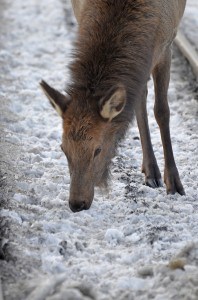
In the first four months of the year, eight animals have died on the railway tracks within Jasper National Park—four of those have died in town.
The most recent mortality was on March 24, when a mule deer was struck by a train just inside the town boundary. Another mule deer was killed the day before, another a week before and yet another 10 days before. Five of the mortalities this year have been deer. The others were a coyote, an elk and a sheep.
According to John Wilmshurst, Parks Canada’s resource conservation manager, each year in the park, between 15 and 30 animals die on the tracks.
He said they’re drawn there by grain spills from Canadian National Railway hopper cars. The spills, which are created by a faulty seal on the gates at the bottom of the cars, can either be large—likely because the train stopped and the grain was able to create a mound—or small, creating a slight sprinkling of food the length of the line.
The grain encourages animals to stay on the tracks to feed and this leads to increased mortality.
“The animals wouldn’t be on the tracks if it wasn’t for the grain,” said Wilmshurst.
“There’s evidence that animals use [rail lines] as movement corridors down in Banff, but in Jasper, with our valley being so wide open, that’s not the dominant reason that animals are on the tracks—it’s the grain.”
This isn’t a new problem. In fact, 10 years ago Parks and the Jasper Environmental Association lobbied CN to purchase a vacuum truck to clean up the spills.
In 2005, that lobbying paid off and a truck was brought to town.
But, according to Warren Chandler, a spokesperson for CN, that truck was removed about a year ago “due to the fact that there was no requirement for its use in the previous years it was based in Jasper.”
Since CN owns the right-of-way that runs through the park, it is outside Parks jurisdiction.
Jill Seaton, who fought for the vacuum truck as a member of the environmental association, said she finds the news of its removal disturbing.
“They need a truck here, certainly to pick the big piles of grain up. I cannot believe they said there was no need for it here. Obviously there is.
“It really is so awful. They’re killing so many animals.”
Seaton admitted that vacuum trucks aren’t the only answer to this issue, noting that they’re perfect for large spills, but impractical for small spills, where the grain gets between the track ballasts—the crushed stone that forms the trackbed.
But even so, she said the truck does help with the larger spills and needs to be in use.
Wilmshurst said Parks is working with CN to try and get it back. In the meantime, when there is a large spill in the yard, CN alerts Parks.
“They’ll report those and we’ll go out and we’ll shovel it up to make sure the animals don’t have access to it.
“Most of the spills happen in the railyard area because the trains are stopped and you get a big mounding of grain.”
In an effort to stop such spills, CN had a program to fix its hopper cars that ran from 2007 to 2011. According to Wilmshurst, 35 per cent of the cars were fixed during that time. But, there was no noticeable difference in the amount of grain on the tracks.
Parks even did a study in an attempt to monitor the issue.
“When they were fixing their trains from 2007 to 2011, we were monitoring the grain in the tracks, so we put these little wooden boxes with a screen on it and that would collect grain.
“We found that even though they fixed 35 per cent of the trains, the grain spill issue didn’t go away. The actual amount being spilled didn’t change.”
Although that’s the case, Wilmshurst said the only way to fix this problem would be to get all of those cars fixed, or for CN to change over to closed containers for shipping grain. That would take away the opportunity for leakages.
“It’s a pretty challenging issue,” he said.
Nicole Veerman
[email protected]
